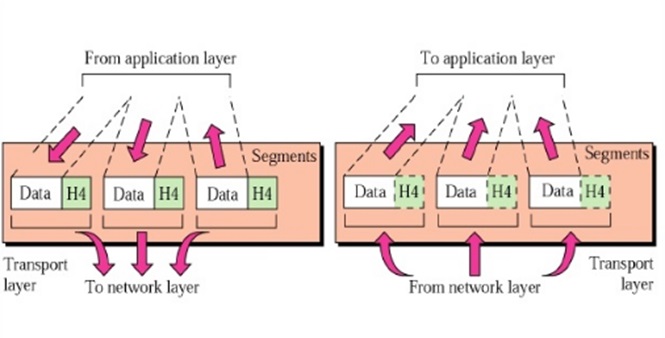osi七层模型传输层
什么是传输层? (What is Transport Layer?)
The Transport Layer in the Open System Interconnection (OSI) model is responsible for end-to-end delivery over a network. Whereas the network layer is concerned with the end - to- end delivery of individual packets and it does not recognize any relationship between those packets.
开放系统互连(OSI)模型中的传输层负责通过网络进行端到端交付。 然而,网络层与单个数据包的端到端传输有关,并且网络层无法识别这些数据包之间的任何关系。
This layer treats each packet independently because each packet belongs to a different message.
该层独立地对待每个分组,因为每个分组属于不同的消息。
The transport layer ensures that each message should reach its destination completely and in order so that it maintains error and flow control to the source to destination to ensure proper data transmission.
传输层确保每条消息都应完全按顺序到达其目的地,以便保持从源到目的地的错误和流控制,以确保正确的数据传输。
The transport layer establishes a connection between two end ports. A connection is a single logical path from source to destination which is associated with all the packets in a message.
传输层在两个端端口之间建立连接。 连接是从源到目的地的单个逻辑路径,它与消息中的所有数据包关联。
Transport Layer uses some standard protocols to enhance its functionalities are TCP(Transmission Control Protocol), UDP( User Datagram Protocol), DCCP( Datagram Congestion Control Protocol), etc.
传输层使用一些标准协议来增强其功能,例如TCP(传输控制协议),UDP(用户数据报协议),DCCP(数据报拥塞控制协议)等。
This figure shows the relationship of the transport layer to the network and session layer.
该图显示了传输层与网络和会话层的关系。

Transport Layer
传输层
传输层的设计问题 (Design Issues with Transport Layer)
Efficient delivery of data with proper correction.
通过适当的校正有效地传递数据。
From the technological changes separate all upper layers.
从技术变化中分离所有上层。
Managing error control and flow control.
管理错误控制和流控制。
Obtaining data from the Session layer, divide it into segments and transmit to the network layer.
从会话层获取数据,将其分成多个部分,然后传输到网络层。
传输层的功能 (Functions of the transport layer)
Specific functions of the transport layer are as follows:
传输层的特定功能如下:
1. Service-point addressing
1.服务点寻址
Computers often run many programs at the same time. Due to this, source-to-destination delivery means delivery from a specific job (currently running program) on one computer to a specific job (currently running program) on the other system not only one computer to the next.
计算机通常同时运行许多程序。 因此,从源到目的地的传递是指从一台计算机上的特定作业(当前正在运行的程序)传递到另一系统上的特定作业(当前正在运行的程序),而不仅仅是从一台计算机传递到下一台计算机。
For this reason, the transport layer added a specific type of address to its header, it is referred to as a service point address or port address.
因此, 传输层在其报头中添加了一种特定类型的地址,称为服务点地址或端口地址。
By this address each packet reaches the correct computer and also the transport layer gets the complete message to the correct process on that computer.
通过该地址,每个数据包到达正确的计算机,并且传输层还将完整的消息发送到该计算机上的正确进程。
2. Segmentation and Reassembly
2.细分和重组
In segmentation, a message is divided into transmittable segments; each segment containing a sequence number. This number enables this layer to reassemble the message.
在分段中,消息分为可传输的段; 每个片段都包含一个序列号。 此数字使该层可以重组消息。
Upon arriving at its destination system message is reassembled correctly, identify and replaces packets that were lost in transmission.
到达目标系统后,消息将正确重组,标识并替换传输中丢失的数据包。
3. Connection Control
3.连接控制
It can be either of two types:
它可以是两种类型之一:
Connectionless Transport Layer
无连接传输层
Connection Oriented Transport Layer
面向连接的传输层
i) Connectionless Transport Layer
i)无连接传输层
This Transport Layer treats each packet as an individual and delivers it to the destination machine.
此传输层将每个数据包视为一个单独的数据包,并将其传递到目标计算机。
In this type of transmission, the receiver does not send an acknowledgment to the sender about the receipt of a packet. This is a faster communication technique.
在这种类型的传输中,接收方不向发送方发送有关数据包接收的确认。 这是一种更快的通信技术。
ii) Connection Oriented Transport Layer
ii)面向连接的传输层
This Transport Layer creates a connection with the Transport Layer at the destination machine before transmitting the packets to the destination.
在将数据包传输到目标之前,此传输层将与目标计算机上的传输层建立连接。
To Create a connection following three steps are possible:
要创建连接,可以执行以下三个步骤:
- Connection establishment
- Data transfer
- Connection termination
When all the data are transmitted connection is terminated. Connectionless Service is less reliable than connection Oriented Service.
传输完所有数据后,连接终止。 无连接服务不如面向连接的服务可靠。
4. Multiplexing and Demultiplexing
4.复用和解复用
Multiple packets from diverse applications are transmitted across a network needs very dedicated control mechanisms, which are found in the transport layer.
跨网络传输来自各种应用程序的多个数据包需要非常专用的控制机制,该机制在传输层中可以找到。
The transport layer accepts packets from different processes. These packets are differentiated by their port numbers and pass them to the network layer after adding proper headers.
传输层接受来自不同进程的数据包。 这些数据包通过其端口号进行区分,并在添加适当的标头后将其传递到网络层。
In Demultiplexing, at the receiver's side to obtain the data coming from various processes. It receives the segments of data from the network layer and delivers it to the appropriate process running on the receiver's machine.
在多路分解中,在接收器端获取来自各种过程的数据。 它从网络层接收数据段,并将其传送到在接收方机器上运行的适当进程。
5. Flow control
5.流量控制
The transport layer also responsible for the flow control mechanism between the adjacent layers of the TCP/IP model.
传输层还负责TCP / IP模型相邻层之间的流量控制机制。
It does not perform across a single link even it performs an end-to-end node.
即使执行端到端节点,它也不会跨单个链接执行。
By imposing flow control techniques data loss can be prevented from the cause of the sender and slow receiver.
通过采用流控制技术,可以防止由于发送方和接收方速度慢造成数据丢失。
For instance, it uses the method of sliding window protocol in this method receiver sends a window back to the sender to inform the size of the data is received.
例如,它使用滑动窗口协议的方法,在此方法中,接收方将窗口发送回发送方以告知接收到的数据大小。
6. Error Control
6.错误控制
Error Control is also performed end to end like the data link layer.
错误控制也像数据链路层一样端对端执行。
In this layer to ensure that the entire message arrives at the receiving transport layer without any error(damage, loss or duplication). Error Correction is achieved through retransmission of the packet.
在这一层中,确保整个消息到达接收传输层而没有任何错误(损坏,丢失或重复)。 通过重发分组来实现纠错。
The data has arrived or not and checks for the integrity of data, it uses the ACK and NACK services to inform the sender.
数据是否到达,并检查数据的完整性,它使用ACK和NACK服务通知发送方。
Example of Transport Layer
传输层示例

This figure shows an example data coming from upper layers have service point addresses j and k ( j is the address of sending application and k is the address of the receiving application).
该图显示了来自具有较高服务点地址j和k的示例数据(j是发送应用程序的地址,k是接收应用程序的地址)。
Since the data size is greater than the network layer can occupy. The data are divided into two packets. Each packet containing the service point addresses ( j and k).
由于数据大小大于网络层可以占用的大小。 数据分为两个数据包。 每个包含服务点地址(j和k)的数据包。
In the network layer, network addresses (A and P) are combined with each packet.
在网络层中,网络地址(A和P)与每个数据包组合在一起。
The packet may travel on different paths and arrive at the destination either in order or out of order.
数据包可能在不同的路径上传播,并有序或无序到达目的地。
The two packets are transmitted to the destination network layer. This is responsible for removing the network layer headers.
这两个数据包被传输到目标网络层。 这负责删除网络层标头。
Two packets are now passed to the transport layer, where they are combined for delivery to the upper layers.
现在将两个数据包传递到传输层,在此处将它们组合在一起以传递到上层。
翻译自: https://www.includehelp.com/computer-networks/functions-of-transport-layer-in-the-osi-model.aspx
osi七层模型传输层







 传输层在OSI模型中负责端到端的数据传输,通过服务点地址进行寻址,确保数据的正确性和顺序。它分为无连接和面向连接的传输,如TCP和UDP,提供错误控制、流控制、复用和解复用等功能。传输层通过序列号进行数据分段和重组,以适应网络层的传输限制。
传输层在OSI模型中负责端到端的数据传输,通过服务点地址进行寻址,确保数据的正确性和顺序。它分为无连接和面向连接的传输,如TCP和UDP,提供错误控制、流控制、复用和解复用等功能。传输层通过序列号进行数据分段和重组,以适应网络层的传输限制。
















 572
572

 被折叠的 条评论
为什么被折叠?
被折叠的 条评论
为什么被折叠?








